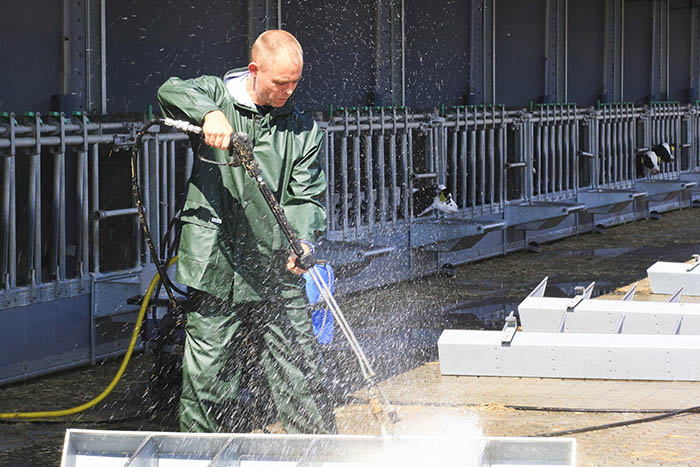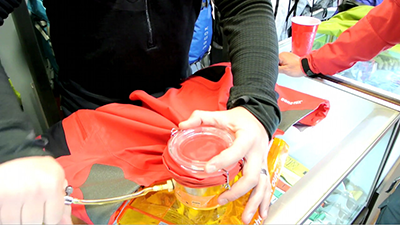Waterproof Workwear Buyers Guide
WORKING WATERPROOFS BUYERS GUIDE
Your Guide to Water and Weatherproof Workwear.

Waterproof and weatherproof clothing is subject to the PPE Regulations only when it is necessary to protect workers against adverse weather (and hazardous substances) that could otherwise, potentially affect their health and safety. Offshore workers, coast guard, farmers and forestry workers are a few that would be affected along with those working in construction and traffic control, who spend long hours working outside.
Waterproof workwear comes in many forms. We stock waterproof suits, trousers, jackets/ coats, overtrousers and safety wellingtons. Many of these products are available in hi-vis options, including railway spec (GO/RT) clothing.
Embroidery is possible on some of our working waterproofs, however printing is more usual - and recommended - because the embroidery process leaves tiny holes in the fabric nullifying the waterproof properties of the garment.
Safety standards you may see used in product descriptions are:
• EN343: Protection against rain
• EN ISO 20471: High visibility clothing
• GO/RT 3279: High visibility clothing to be worn by UK Railway maintenance workers
Working with Cement
Waterproof clothing, gloves and boots should be worn when working with cement and cement/ water mixture to ensure it does not come into contact with skin.
Sheep Dips
Wellington boots and waterproofs trousers and jacket, or coveralls, in nitrile or PVC fabrics should be worn over coveralls.
Forestry
A waterproof jacket should be worn with correct Chainsaw PPE.
Construction
Waterproof Jacket and in really bad conditions, waterproof overtrousers, along with other essential PPE.
Offshore Industries
Outer clothing should be water and windproof, high visibility, flame retardant and anti-static.
Farming
Waterproof coveralls would be the most comfortable for all day use. Waterproof overtrousers and wellingtons are ideal in very wet/ muddy conditions, or where there is a risk of chemicals in the mud or surface water.

Types of Waterproof Fabric
Various names are given to waterproof fabrics, although the ones you are most likely to come across are:
• PVC - Polyvinyl chloride -a man-made polymer fabric with waterproof properties and so is used in coats, jackets, footwear and aprons
• Nitrile - an oil resistant rubber, usually used in work gloves and gauntlets, aprons and boots
• PU Coated - Fabrics are sprayed with PU (polyurethane) coating before being made into garments
• Polyester - a man-made fabric which is exceptionally strong and durable. It is waterproof and quick drying, retains its shape in harsh conditions and is easily washed
• DWR - Durable Water Repellent coating. Another way of coating fabric, after a laminate or membrane has been applied to provide a protective barrier. DWR needs to be reapplied and can be retreated to improve performance. Washing can remove the water repellent coating so you should use a specific product to refresh it
• GoreTex - The brand name of the best established microporous membrane fabric. Provides excellent levels of waterproofing and breathability

Measuring Levels of Waterproofing by Testing
The waterproof capabilities of a fabric are tested using one of two methods;
In the Water Column Test a tube, measuring 1inch in diameter, is filled with water and the fabric is held taught beneath this (sealed) column of water. The fabric is then tested over 24 hours to see how many milimeters of water the fabric can withstand before leaking. When the fabric begins to seep water, the mm is noted as a score and this is known as the 'hydrostatic head'.
PSI (Pounds per Square Inch) relates to the amount of pressure a garment can withstand both from the pressure exerted by the wearer inside the garment and the external weather conditions. PSI can be converted in mm for simplicity.
To be 100% waterproof, the British Standard of 3PSI must be met; this will withstand 1500mm of pressure. However, most garments will usually exceed this value at 40PSI. The higher the PSI, the more effective the waterproofing will be. Higher PSI ratings will usually indicate higher garment price.
Fabric Breathability
Breathable garments allow moisture vapours to be released quickly from the garment and enable drying to happen quickly. Breathable garments are particularly important if you are very active as they will provide comfort and dryness. Breathability is dependent upon a fabric's ability to transport moisture and vapours from the inside to the outer layer (permeability). Waterproofing and breathability are achieved when the pores of the fabric are small enough to block large water particles from seeping through, whilst allowing smaller sweat particles to pass through from the inside to the outside of the fabric.
Oil and dirt from the skin can block the pores of the fabric and reduce breathability.
Testing Breathability
These tests show how many grams of water vapour are able to pass through a fabric in a set period of time. The results of these tests are then shown as;
g/m²/24 hours, or as a RET (Resistance of Evaporation of a Textile) or as an MVT (Moisture Vapour Transmission).
MVT
Moisture vapour transition relies on there being a difference of pressure/ temperature between the inside and outside of a breathable garment, because the fabric works by equalising the pressure and heat between the inside and outside of the jacket. Once moisture reaches the inner face of the fabric it must pas through the fabricand then evaporate on the surface. If the moisture cannot pass through the fabric, ir if the rate of transmission is slower than the arrival of more moisture, transmission rates will be lower and could allow condensation to build up on the inside of the garment.
• For this reason, breathable garments function at their best when the air inside is humid and warm and the air outside is cold and dry.
• Breathable garments are most effective if they are close fitting. This is because if the mid and outer layers are not in contact the moisture vapours will come into contact with the cooler air betwen layers, promoting condensation build up.
• If the moisture vapour transition rate is exceeded, for example when exerting yourself, it will possibly cause condensation to form.
RET
This test simply shows the levels of resistance a fabric has to allow evaporation. The lower the resistance (or RET) the better the breathability. Therefore a RET of 0 has excellent breathability, whereas a RET of 30+ has very poor breathability.
Ways of Testing the Fabric
The fabric is put through testing to measure how much water can pass through, and how much is absorbed by, the fabric. In each test the fabric is secured across a cup and tested over 24 hours. After this time the cup is weighed showing the amount of water that has either passed through the fabric into the cup; the result of this indicates grams per square metre (written as gr/24hrs/m²) that the fabric can release as moisture. The higher the amount, eg 10,000gm, the higher the level of breathability. Also shown from these tests is the amount of water absorbed and held by the fabric; this amount shows the moisture vapour transmission rate (MVTR).

The RET is tested by means of 'the Sweating Hot Plate Test'. In this test body heat is mimicked by a metal plate which is heated to simulate the temperatures that induce sweat. The fabric is added to the plate, as is water and the plate is kept at a constant temperture and measured to show the evaporation process- how much eneregy is being used to keep the plate cool (as happens in real life when moisture is released through fabric to keep the body at a constant temperature). The result is demonstrated as a RET.
Wicking
'Wicking' refers to a garment's ability to progress moisture away from the skin via the fibres of the fabric, so that it can dry quickly rather than be absorbed. Therefore materials like cotton and wool which are porous become heavier when wet and are not wicking, whereas many fleece fabrics are wicking.
